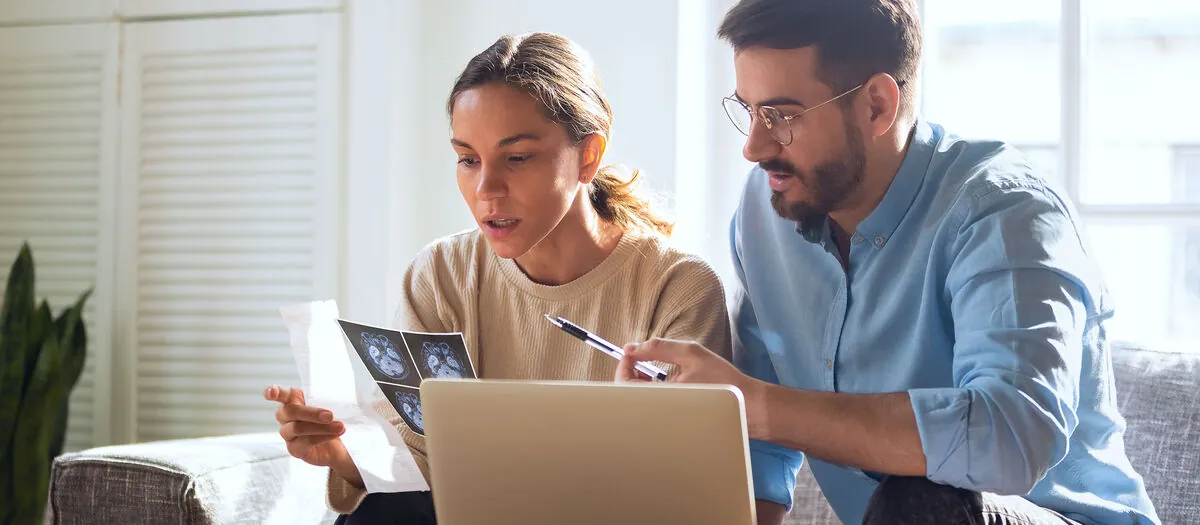
Parkinson’s disease:
symptoms, causes and treatment
Parkinson’s is a brain disease that usually manifests itself in muscle stiffening. The patient’s arms and legs tremble even when at rest. Parkinson’s cannot be completely cured, but the symptoms can be treated so that patients can lead a largely independent life. Read on to find out what Parkinson’s disease is, how it manifests itself and what treatment options are available.
Parkinson’s disease or Parkinson’s syndrome is a neurological disease in which certain nerve cells in the brain are damaged. As a result, they are no longer able to produce the messenger substance dopamine, which is responsible for controlling the musculoskeletal system. This leads to characteristic movement disorders, such as a slow gait with small steps and trembling.
The average age at the time of diagnosis is 60 years, and the disease is equally common in men and women. In Switzerland, around 15,000 people are affected by Parkinson’s.
The main symptoms of Parkinson’s are:
- Trembling (tremor). Tremor can occur during periods of rest or stress and usually affects individual fingers, legs or feet. In principle, however, the head and tongue as well as the entire body may also be affected.
- Muscle stiffness (rigidity). Patients find it difficult to carry out movements, experiencing a feeling of resistance when stretching and bending muscles.
- Slower movements. It is particularly difficult for patients to start muscle activities (bradykinesia). Freezing (inability to initiate a movement) is also characteristic.
- Disturbances in balance (postural instability). The risk of falling forwards or backwards when standing or walking is increased. The result is a stiff and stooped gait.
In addition to the symptoms characteristic of Parkinson’s disease, which mainly affect the musculoskeletal system, there are also other associated symptoms. Some of them go hand in hand with personality changes:
- Depression
- Hallucinations
- Language problems
- Sleep disorders
- Dementia
Genetic causes play a minor role. Although there is a gene mutation that causes Parkinson’s disease to be passed on within a family, this is rarely the case.
Parkinson’s is not easy to diagnose, as the symptoms can often be indicative of other diseases as well. In the medical history interview, the doctor will therefore ask questions about the patient’s medical history and symptoms. This is followed by a physical examination focusing on posture and the patient’s ability to move their limbs.
Reflexes and muscle sensitivity are also checked as part of a neurological examination. Often, patients are also given Parkinson’s medication to find out how they respond to it. Imaging techniques such as computed tomography (CT) or magnetic resonance imaging (MRI) of the brain are also used to rule out a brain tumour. An ultrasound scan (TCS) can help to detect early-stage Parkinson’s.
While Parkinson’s cannot be fully cured, appropriate treatment can dramatically improve the quality of life of those affected. This treatment should be individually tailored to each patient.
Parkinson’s medicines are designed to supply the missing messenger substance dopamine (L-dopa) or to inhibit the depletion of dopamine (MAO-B inhibitors, COMT inhibitors). This helps to eliminate symptoms in the musculoskeletal system. If the medications do not bring about an improvement or the symptoms are very severe, surgery may also be performed in some cases. Deep brain stimulation (DBS) involves placing an electrode in a specific part of the brain that stimulates the area with current impulses – it therefore acts as a brain pacemaker. Additionally, other treatment methods such as physiotherapy, speech therapy or occupational therapy can also be used successfully to combat physical symptoms.
Complementary therapy methods such as acupuncture can also have a positive effect on the symptoms.
Other signs can include trembling, slower movements and a certain degree of clumsiness. This is followed by problems with walking, posture and loss of control over muscles and joints.
In the first few years after starting treatment, medications usually work reliably, so the patient will have few symptoms. Over time, however, the efficacy of the medicines decreases. As a result, the intensity of symptoms often fluctuates over the course of the day. Non-motor symptoms such as depression appear for the first time at this stage or can worsen if they are already present. Many older Parkinson’s patients also develop dementia.
In such cases, it may be helpful to adjust treatment during an inpatient stay at a special Parkinson’s centre. Parkinson’s self-help groups can also help patients and family members to cope with the challenges of living on their own.
In addition, relatives should learn about the illness at an early stage in order to be able to support the affected person in the best possible way. In the final stages, Parkinson’s sufferers are usually dependent on the help of others – especially with regard to personal hygiene and help with eating.
Generally speaking, life expectancy with Parkinson’s is about as high as that of healthy people.
- S3-Leitlinie der Deutschen Gesellschaft für Neurologie: Idiopathisches Parkinson-Syndrom (Stand 2016), unter: https://www.awmf.org/uploads/tx_szleitlinien/030-010k_S3_Parkinson_Syndrome_Idiopathisch_2016-06-abgelaufen.pdf (Abrufdatum 31.10.22)
- Berufsverbände und Fachgesellschaften für Psychiatrie, Kinder- und Jugendpsychiatrie, Psychotherapie, Psychosomatik, Nervenheilkunde und Neurologie aus Deutschland: Parkinson-Syndrom, unter: https://www.neurologen-und-psychiater-im-netz.org/neurologie/erkrankungen/parkinson-syndrom#c557 (Abruf: 31.10.2022)
- Parkinson Schweiz: Was ist Parkinson, unter: https://www.parkinson.ch/parkinsonkrankheit/was-ist-parkinson (Abrufdatum: 31.10.22)
- Universitätsspital Zürich: Parkinson, unter: https://www.usz.ch/krankheit/parkinson/ (Abrufdatum: 31.10.22)
- Universitätsspital Bern: Parkinson, unter: https://neurochirurgie.insel.ch/funktionell-schmerz/parkinson (Abrufdatum: 31.10.22)
- Berlit P.: Klinische Neurologie. Springer.Verlag. 4. Auflage 2020
- Trenkwalder C.: Parkinson. Schattauer Verlag. 2. Auflage, 2015


